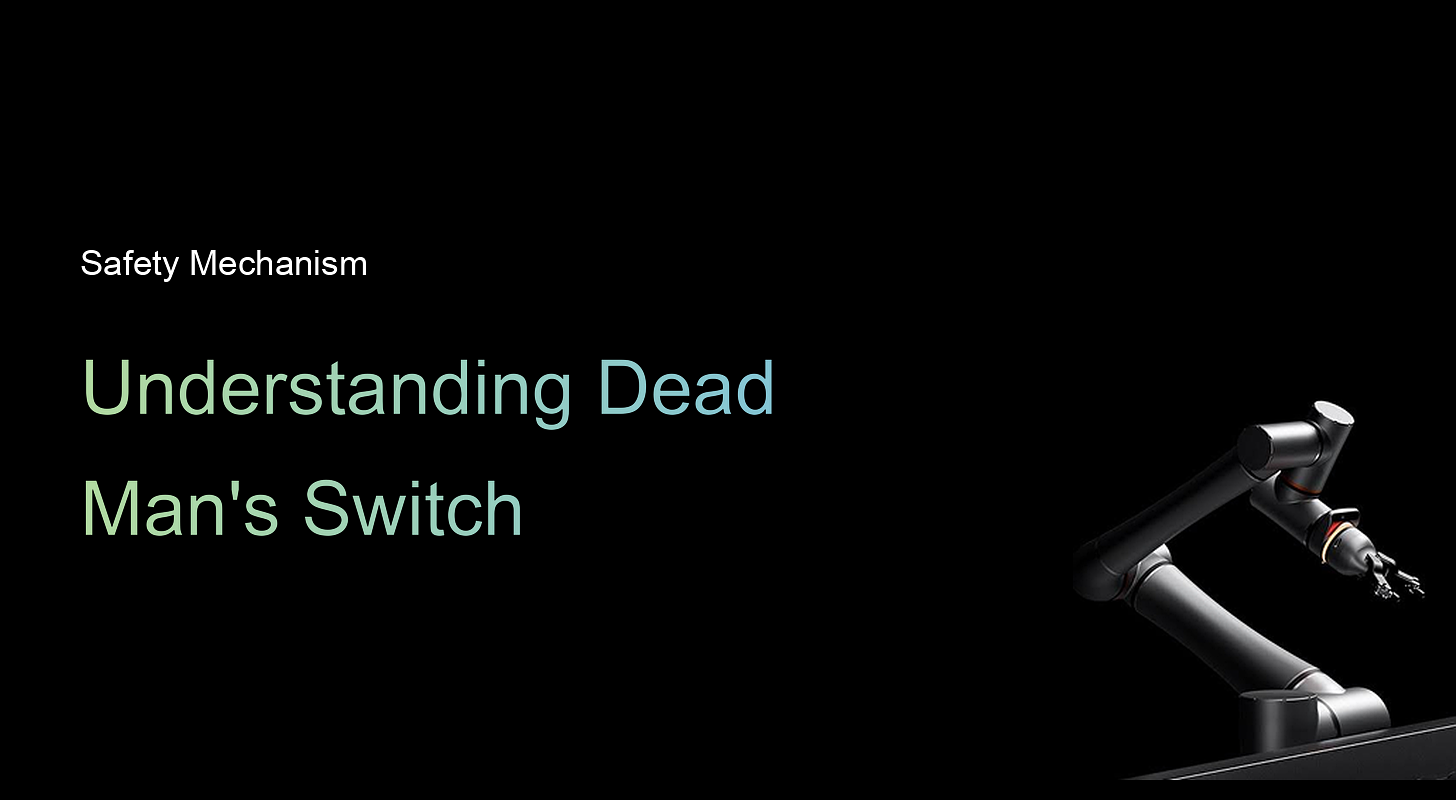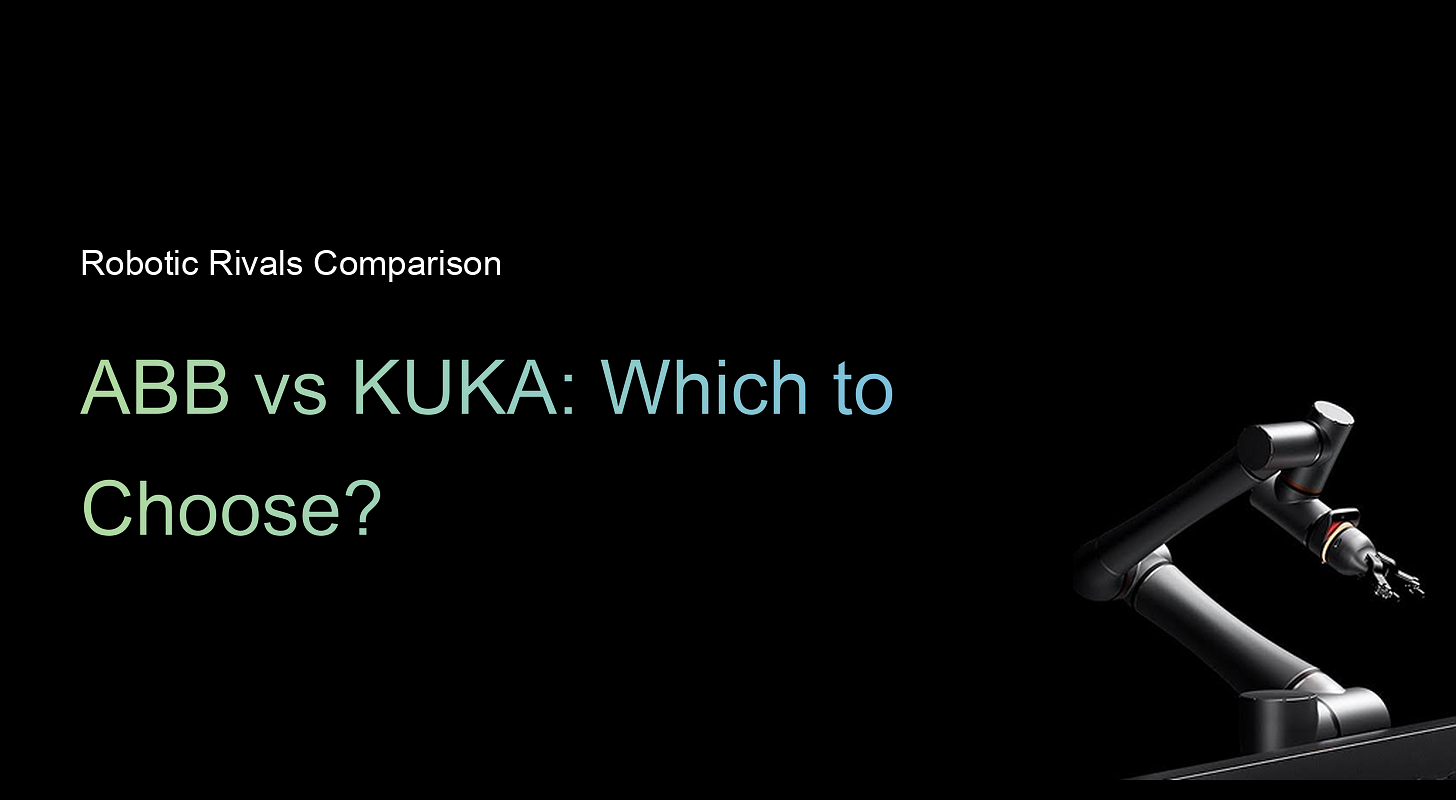KUKA vs. FANUC? FANUC leads with rugged, low-maintenance systems and CNC integration, while KUKA brings German modular engineering and strength in cobots.
So when businesses choose between them, it often comes down to factors like price, programming interface, industry fit, and regional support.
KUKA vs. FANUC is one of the most common comparisons in industrial robotics today. Both brands dominate global automation, from automotive welding to electronics assembly, but they approach robotics differently.
Meet KUKA and FANUC
KUKA and FANUC are leading manufacturers of industrial robots. KUKA is a global automation corporation specializing in intelligent automation solutions, particularly in industrial robotics.
KUKA offers everything from individual robots to fully automated systems and is known for its expertise in areas like e-mobility, electronics, and healthcare. KUKA is even a significant player in Germany's “Industry 4.0” initiative and is headquartered in Augsburg, Germany.
FANUC is a Japanese company that is a world leader in factory automation. It is known for its CNC (Computer Numerical Control) systems, industrial robots, and robomachines. FANUC provides a wide range of products and services aimed at automating various manufacturing processes.
FANUC integrates smoothly with CNC machines and uses programming tools like TP programming, iRVision, and Roboguide simulation. Its robots are widely deployed in Asia and North America thanks to a massive support network and OEM compatibility.
You can see how both stack up in broader comparisons like KUKA vs. ABB vs. FANUC.
Key differences between KUKA and FANUC robots: TL;DR
Performance and capabilities
KUKA
KUKA focuses on strength and flexibility. Its heavy-duty arms, such as the KR FORTEC or KR QUANTEC ultra, are capable of handling payloads up to 300 kg, and KUKA's KR 1000 titan series handles payloads over 1,000 kg. All while QUANTEC still maintains repeatability in the ±0.05 mm range.
KUKA’s modular architecture allows for easy reconfiguration, making it suitable for high-mix environments like automotive body shops or aerospace tooling. While not as fast as FANUC in light-payload applications, KUKA robots shine when stability and force are prioritized.
If your needs are centered around payload handling, multi-step assembly, or large-part welding, KUKA offers more flexibility. If you need rapid part transfers, CNC integration, or cycle-time reduction, FANUC is typically the stronger choice.
FANUC
FANUC is built for speed. Its robots are optimized for high-cycle tasks like pick-and-place, packaging, and CNC machine tending. Models like the LR Mate and M-20iD offer elevated axis speeds, with the M-20iD achieving up to 720°/sec on the J6 axis and exceptional motion performance for their class. These are ideal for fast-paced manufacturing lines.
Its precision is also solid, with most FANUC robots achieving repeatability around ±0.03 mm. This makes them reliable for fine electronics assembly and robotic vision tasks using iRVision.
Programming and software
KUKA
KUKA uses its proprietary language, KRL (KUKA Robot Language), which gives advanced users granular control over robot behavior. KRL comes with a learning curve but offers the flexibility engineers need for complex, sensor-driven routines.
KUKA also provides KUKA WorkVisual, a project-based configuration and commissioning tool that integrates logic, hardware, and motion in one place. For easier programming, KUKA now offers iiQKA.OS, a no-code graphical interface aimed at small shops and first-time users.
It’s especially helpful for collaborative applications like pick-and-place or light assembly, making the brand more accessible across industries.
FANUC
FANUC takes a different route with TP (Teach Pendant) programming, where you teach robot positions and logic using a handheld interface. It’s intuitive for those familiar with CNC operations and doesn’t require prior coding knowledge. FANUC’s ecosystem includes:
- iRVision: A built-in machine vision system that integrates smoothly with robots
- Roboguide: A full offline simulation tool for testing programs and cycles before deployment
- iPendant: A web-based version of the teach pendant for remote configuration and monitoring
In terms of accessibility, FANUC typically has a shorter learning curve, especially in CNC-heavy environments. KUKA’s software stack is more customizable and modular, which appeals to integrators and manufacturers with complex workflows.
Model line-up and specializations
KUKA’s lineup is built around flexibility, strength, and modularity.
Its top three models include:
KR QUANTEC
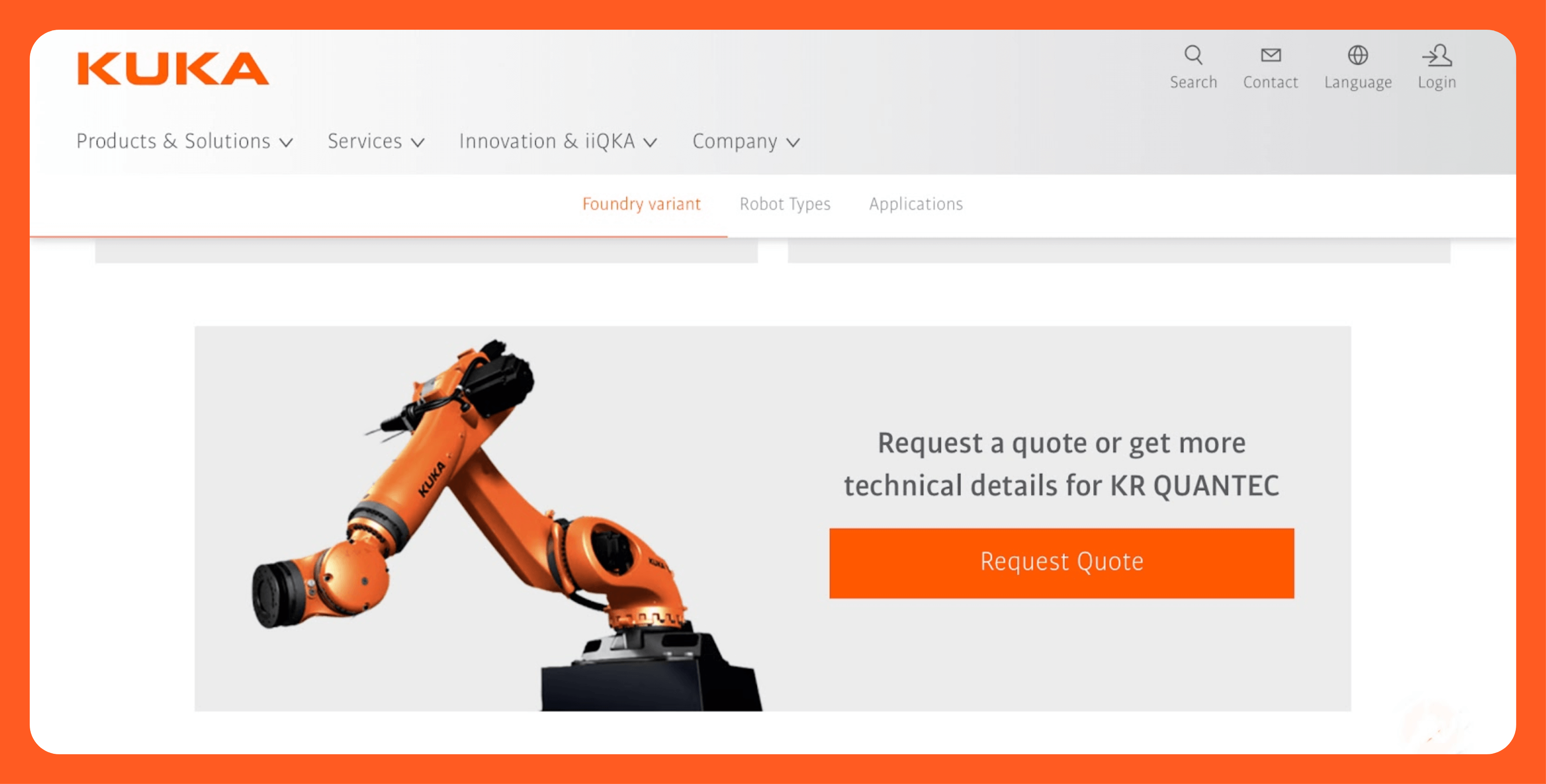
KR QUANTEC is a versatile workhorse for medium to heavy-duty tasks. Payloads range from 90 to 300 kg, making it ideal for automotive body shops, spot welding, and palletizing. It’s known for long reach, modular design, and low total cost of ownership.
KR AGILUS
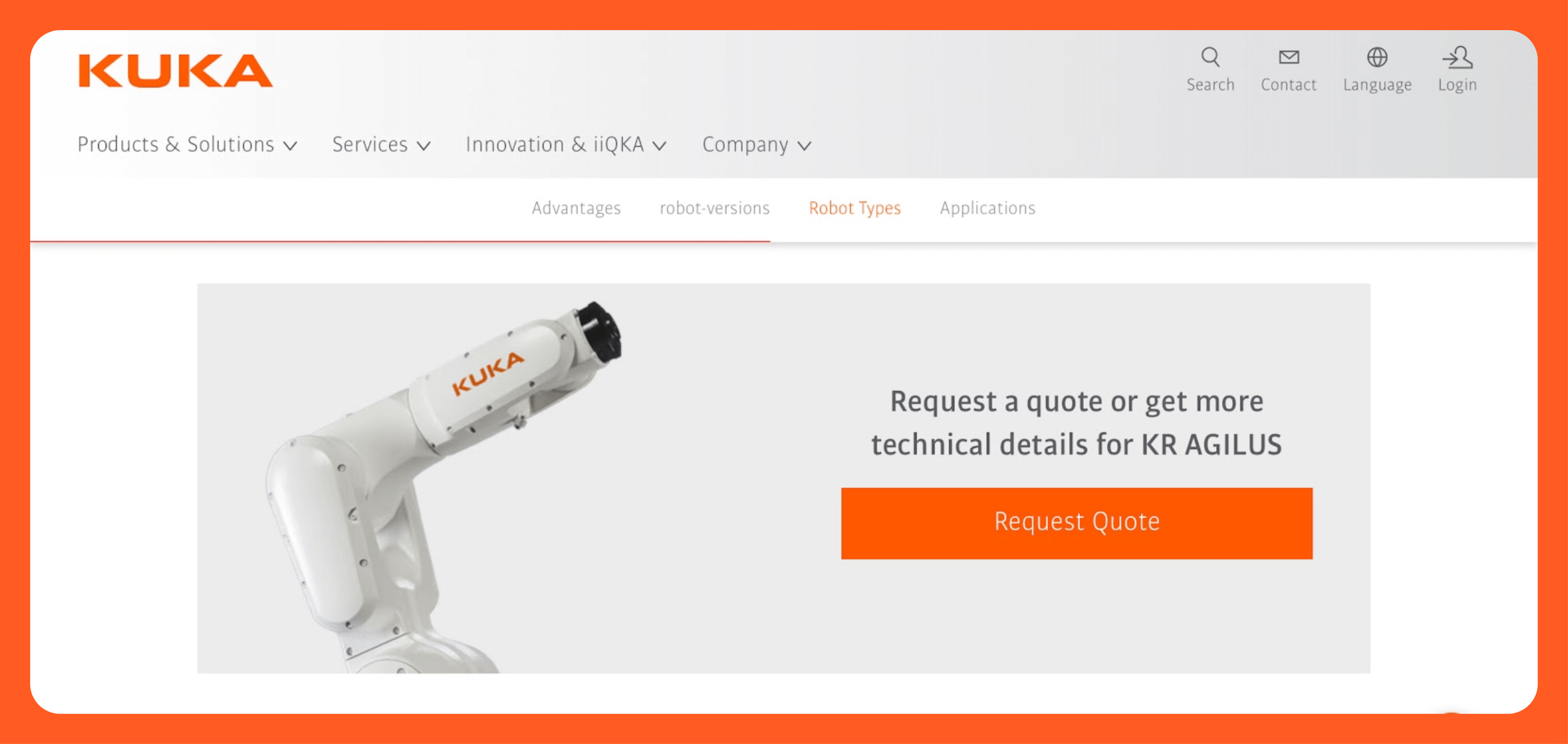
KR AGILUS is a compact, high-speed 6-axis robot designed for precision tasks in confined spaces. With payloads up to 10 kg and a small footprint, it’s widely used in electronics, testing, and lab automation.
LBR iiwa
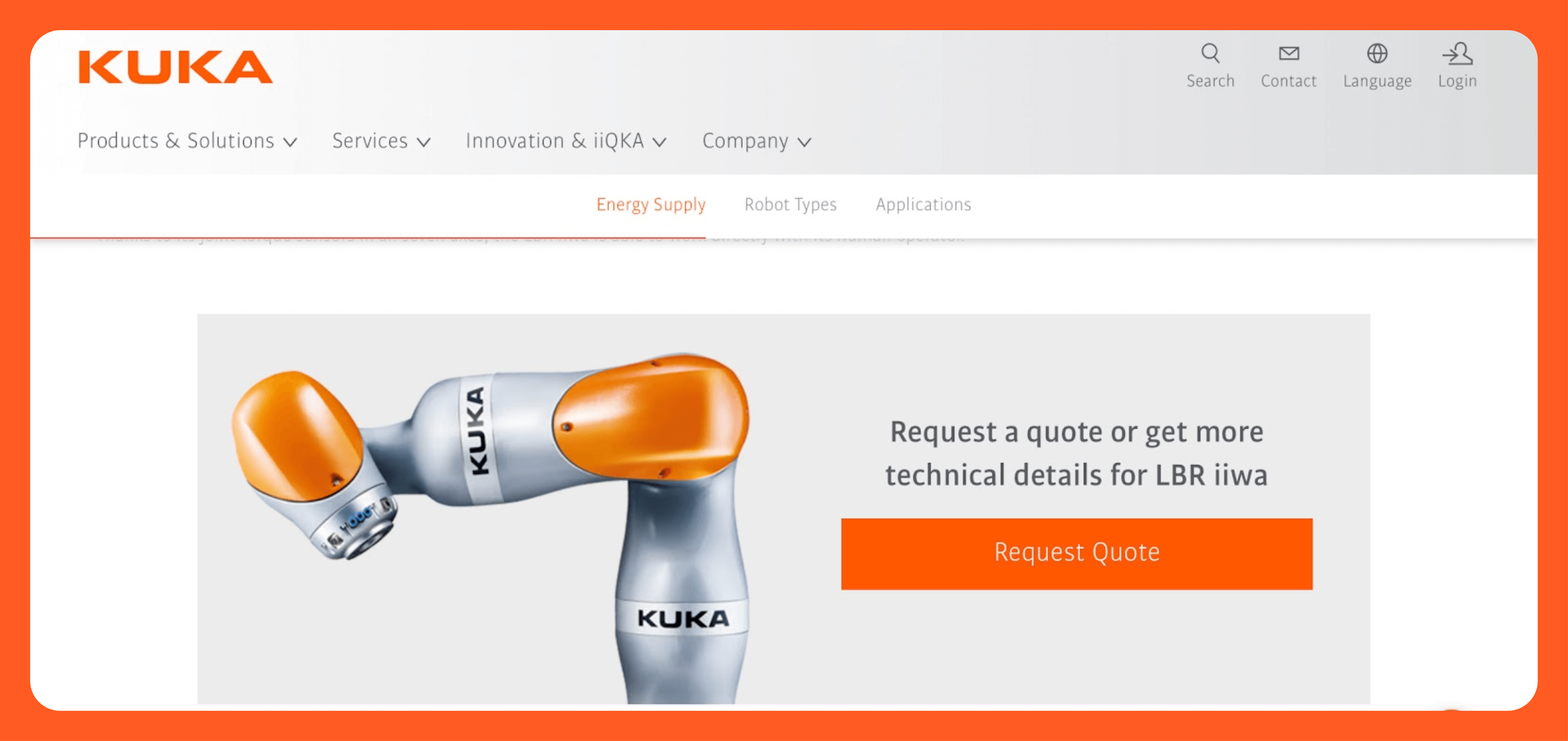
LBR iiwa is KUKA’s flagship collaborative robot (cobot), offering force-sensitive joints and 7-axis articulation. It’s designed for human-robot collaboration in light assembly, inspection, and electronics.
FANUC’s top models are focused on speed, simplicity, and CNC integration:
ARC Mate Series
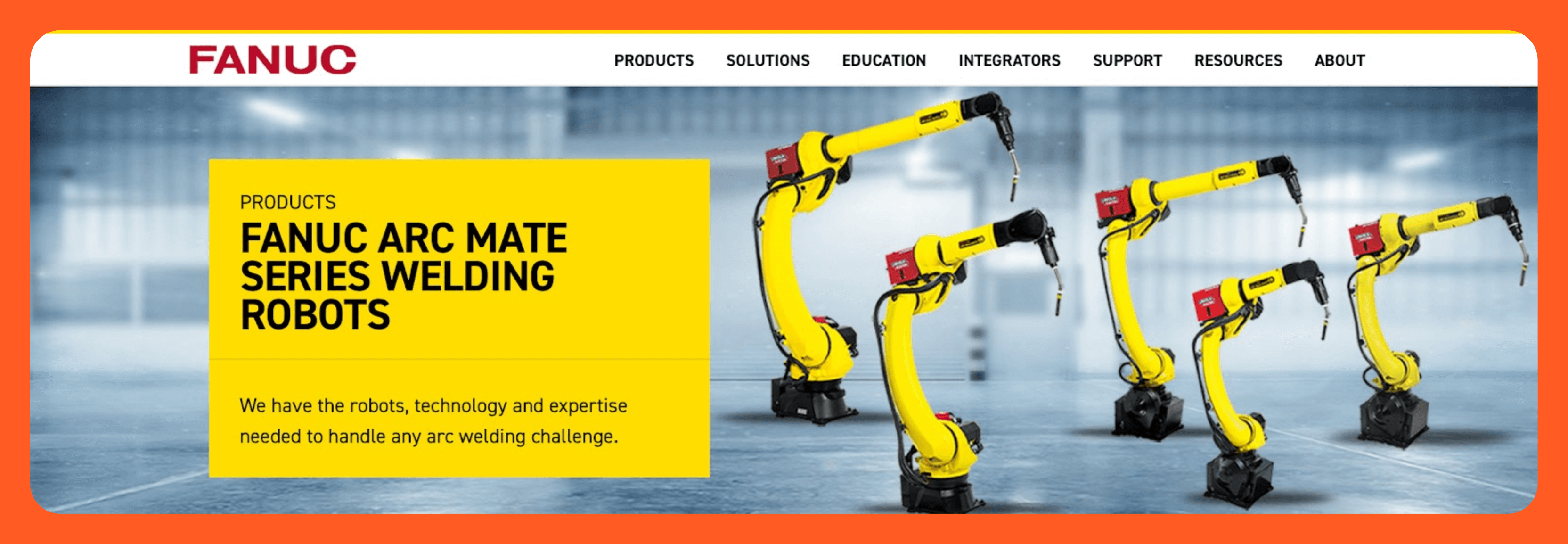
Optimized for robotic welding, the ARC Mate Series offers precise, repeatable motion and smooth integration with welding power sources. It supports payloads from 7 to 25 kg, with IP-rated protection for harsh environments.
M-20iD
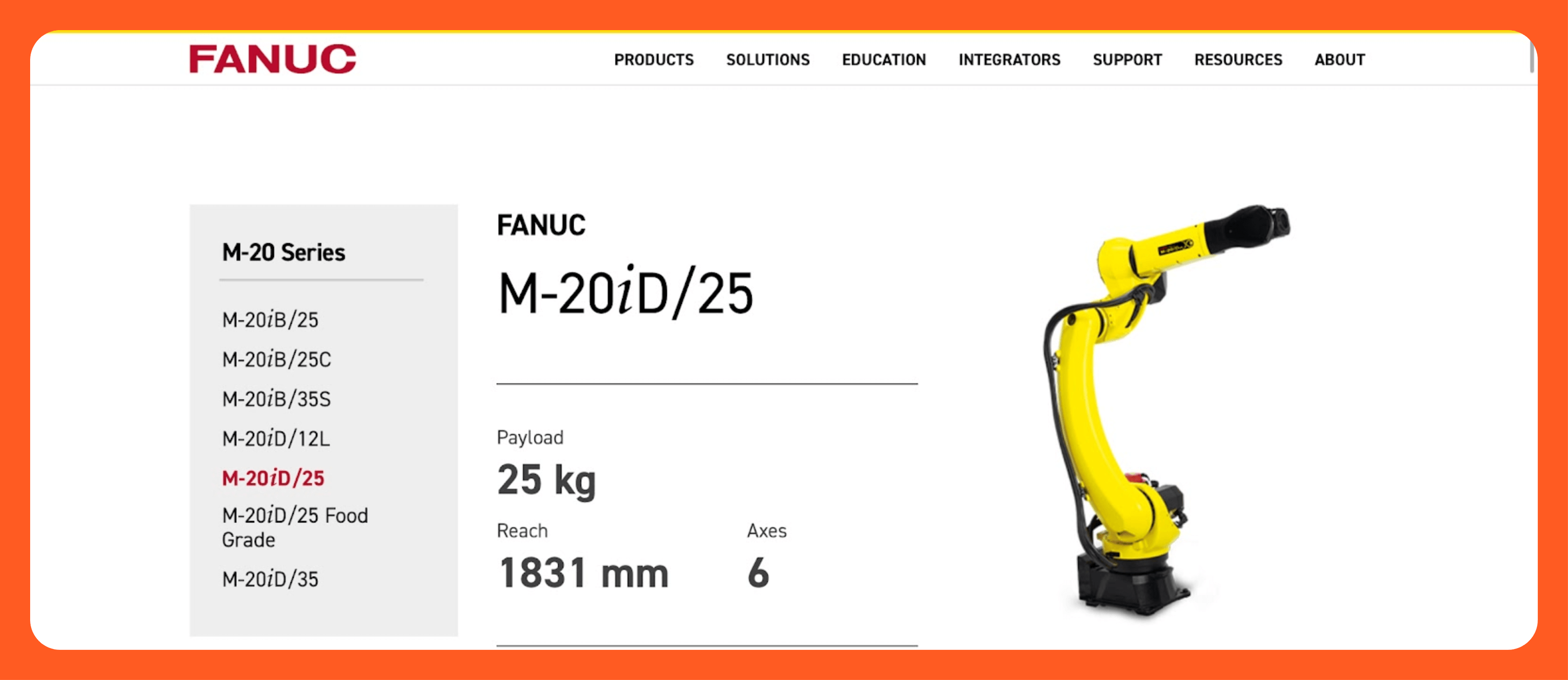
A versatile mid-range industrial robot with a compact footprint and a payload capacity of up to 25 kg, M-20iD is optimized for high-speed handling in machine tending, palletizing, and sub-assembly lines. Its slim arm design and internal cable routing make it ideal for tight workcells and reduced downtime.
CRX Series
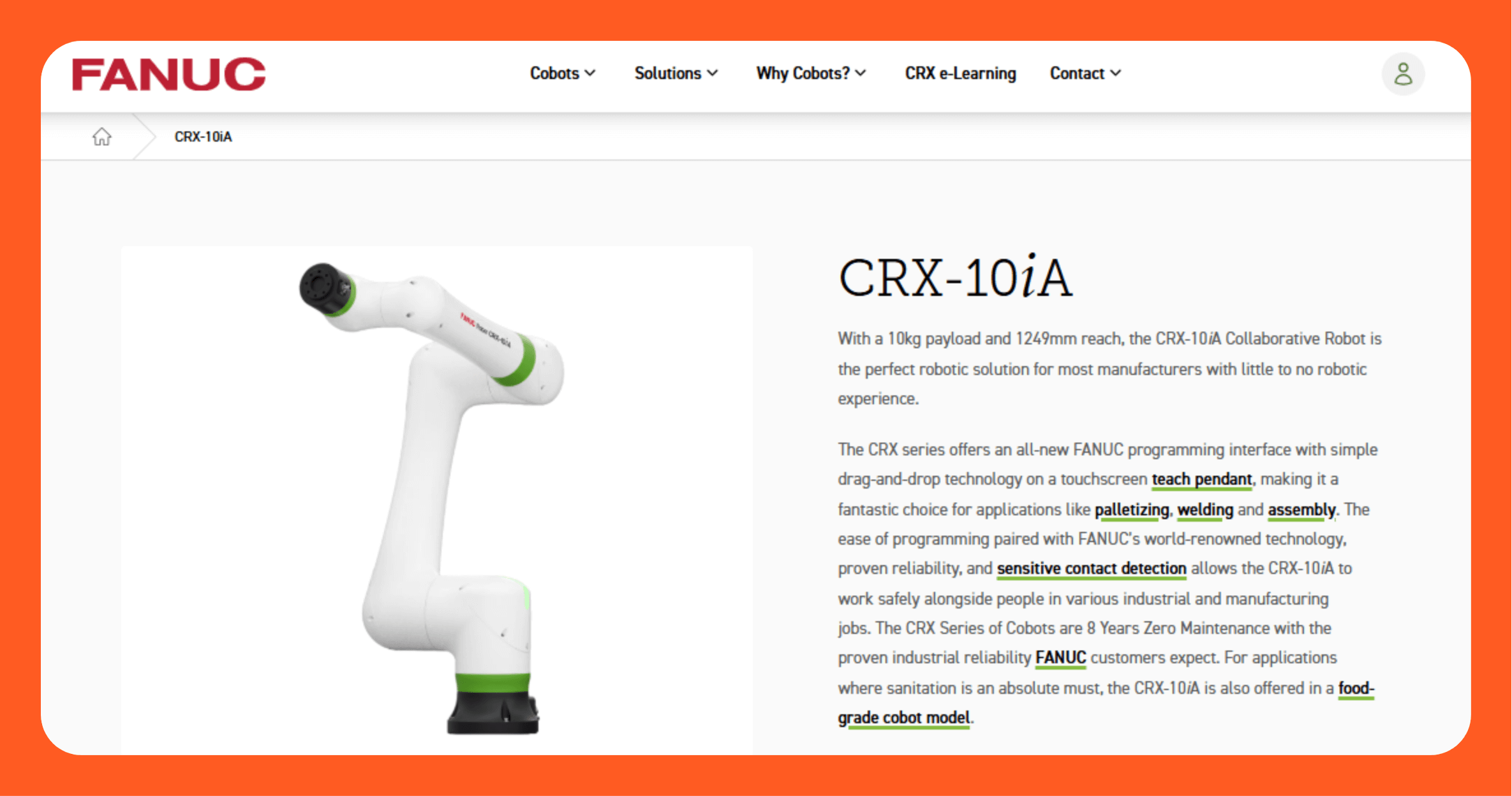
The CRX-10iA is FANUC’s lightweight cobot offering up to 10 kg payload, perfect for collaborative tasks. It features drag-and-drop programming, safe operation without cages, and quick setup, even for non-engineers. Widely used in packaging, inspection, and small part handling across first-time automation deployments.
Both KUKA and FANUC have extensive catalogs, but these models represent the core strengths of each brand, whether you’re focused on welding, cobots, or high-speed handling.
Pricing comparison
KUKA
KUKA robot prices typically start around $25,000 to $30,000 for entry-level arms like the KR AGILUS and can go over $120,000 for large, heavy-payload models such as the KR FORTEC Ultra. Collaborative options like the LBR iiwa usually fall in the $50,000 to $70,000 range, depending on specs and safety requirements.
FANUC
FANUC robot pricing is in a similar range. A compact model like the LR Mate 200iD may cost ~$30,000 to $40,000, while mid-range systems such as the M-20iD are often quoted between $50,000 and $70,000. FANUC’s newer CRX cobots are competitively priced, generally between $45,000 and $55,000.
Note: These are market estimates based on integrator quotes and public listings. Final pricing may vary by region, distributor, and configuration.
Once you factor in installation, safety systems, programming, and tooling, the total cost of ownership can double.
Here’s a rough comparison:
Integration costs, including controllers, safety fencing, grippers, and software, can add ~$5,000 to $30,000+, depending on the application.
Maintenance and reliability
KUKA
KUKA focuses on modular repairability. Its robots use interchangeable components, especially in the KR and AGILUS lines, so field servicing is often faster and more cost-effective. While KUKA arms may require more frequent tune-ups in harsh environments, the modular architecture allows quicker replacement of actuators, joints, or sensors without full system teardown.
In terms of spare parts, FANUC has the edge in global coverage, but KUKA is catching up, particularly in Europe, where local support and part sourcing are stronger. Both companies offer maintenance contracts and online diagnostics, though FANUC’s service network is currently wider.
FANUC
FANUC is well-regarded for its low-maintenance hardware. Its robots are built with sealed components, long-life gearboxes, and minimal lubrication requirements. Many units run for 15+ years with basic preventive maintenance.
For high-speed or CNC-integrated environments where downtime is costly, FANUC’s track record of reliability is a major selling point. It also helps that FANUC offers predictive maintenance tools and extensive parts availability across Asia and North America.
Global support and training
KUKA
KUKA has a strong base in Europe, with a growing presence in North America and Asia. While its service footprint isn’t as vast as FANUC’s, it’s rapidly expanding through integration partners and local training centers.
KUKA offers hands-on training via its KUKA College programs, covering KRL programming, hardware setup, and WorkVisual usage. Virtual training and certification options have also become more accessible in 2025.
FANUC
FANUC has one of the most extensive support networks in industrial robotics. With major service hubs across North America, Asia, and Latin America, most manufacturers can access in-person support, spare parts, or certified integrators quickly. FANUC also offers online training, onsite commissioning support, and long-term service plans tailored for CNC-heavy facilities.
Its training resources are widely available in multiple languages and include everything from basic TP programming to advanced iRVision and Roboguide modules.
Use cases and industry fit
KUKA
KUKA is a go-to brand in manufacturing industries that demand high payloads, precision welding, and modular assembly lines. Automotive manufacturers have long relied on KUKA’s KR QUANTEC and KR FORTEC series for spot welding, handling large body panels, and tool-heavy operations.
In aerospace, KUKA robots are used for drilling, composite layup, and fastener installation thanks to their extended reach and stability. Its cobots, like the LBR iiwa, are gaining traction in modular production cells where human-robot interaction is needed for fine assembly or inspections.
FANUC
FANUC, by contrast, dominates environments where speed and repeatability matter. Think electronics assembly, packaging lines, and CNC machine tending. Its M-20iD and LR Mate series are staples in high-throughput factories, where small components need fast, repetitive movement.
FANUC’s CRX cobots are commonly deployed in palletizing, pick-and-place, and basic handling, especially in facilities already running FANUC CNC systems, where integration is smooth.
Side-by-side comparison: RO1 vs KUKA vs FANUC
Final thoughts: Is your operation better suited for KUKA or FANUC?
Choosing between KUKA and FANUC comes down to your automation priorities:
- Pick KUKA if your operation involves heavy payloads, complex welding, or modular production lines. It’s a great fit for European factories and high-mix assembly setups.
- Go with FANUC if speed, CNC compatibility, or low-maintenance uptime are critical. It excels in high-throughput, repetitive workflows, especially in CNC-integrated environments.
Try to factor in your team’s experience, support availability, and long-term costs. And if you want something faster to deploy and easier to use, RO1 is worth testing.
Next steps with Standard Bots
Still choosing between KUKA and FANUC? Standard Bots’ RO1 is the perfect six-axis cobot addition for any industrial automation setup, delivering unbeatable precision and flexibility.
- Affordable and adaptable: RO1 costs $37K. Get high-precision automation at half the cost of traditional robots.
- Precision and power: With a repeatability of ±0.025 mm and an 18 kg payload, RO1 handles even the most demanding CNC jobs.
- AI-driven simplicity: Equipped with AI capabilities on par with GPT-4, RO1 integrates seamlessly with CNC systems for advanced automation.
- Safety-first design: Machine vision and collision detection mean RO1 works safely alongside human operators.
Schedule your on-site demo with our engineers today and see how RO1 can bring AI-powered greatness to your shop floor.
FAQs
1. What does FANUC stand for?
FANUC stands for Factory Automation Numerical Control. The company originated as a division of Fujitsu in Japan before becoming an independent leader in CNC systems and industrial robotics, headquartered in Oshino, Japan.
2. What does KUKA mean, and where did the company originate?
KUKA stands for Keller und Knappich Augsburg, named after its founders. The company was established in Augsburg, Germany, in 1898 and began as an acetylene lighting manufacturer before evolving into a global leader in industrial robots and automation systems.
3. Who currently owns KUKA Robotics?
KUKA Robotics is majority-owned by Midea Group, a Chinese multinational company that acquired it in 2016. Midea specializes in appliances, HVAC systems, and industrial automation, and has expanded KUKA’s reach in both manufacturing and service robotics markets.
4. How much does a typical KUKA robot cost in 2025?
A typical KUKA robot costs between $25,000 and $120,000, depending on payload, reach, and application. Collaborative models like the LBR iiwa usually range from $50,000 to $70,000. These figures are market estimates; actual costs vary by region, integrator, and the inclusion of software, tooling, and installation services.
5. Where are KUKA robots manufactured?
KUKA robots are primarily manufactured in Germany, specifically at the company’s headquarters in Augsburg. Production facilities also operate in Hungary, China, and the United States to serve different regional markets and product lines.
6. Which programming language is used for FANUC robots, and how hard is it to learn?
The programming language used for FANUC robots is TP programming, also called Teach Pendant programming. It’s a menu-driven interface that doesn’t require prior coding knowledge, making it relatively easy to learn for beginners. Advanced users can also expand functionality using KAREL, FANUC’s text-based language.
7. Can KUKA and FANUC robots be integrated with ABB systems?
KUKA and FANUC robots can be integrated with ABB systems if communication protocols like Ethernet/IP or PROFINET are aligned. Successful integration depends on compatible control platforms, I/O setups, and sometimes middleware or PLC programming. Many integrators use third-party solutions to bridge differences between brands.
Join thousands of creators
receiving our weekly articles.










.png)
